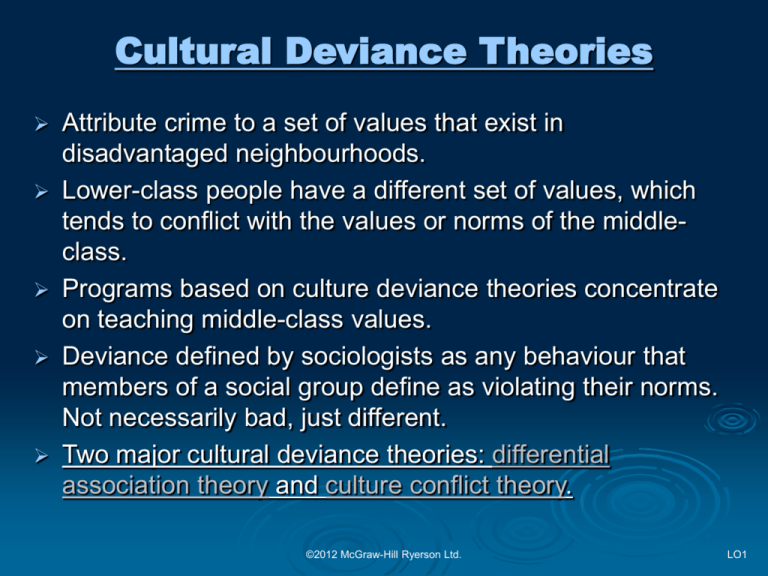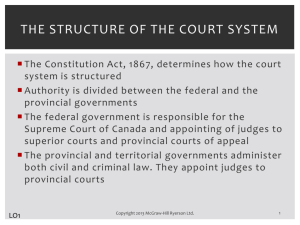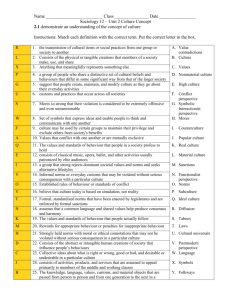Cultural Deviance Theories - McGraw-Hill
advertisement

Cultural Deviance Theories Attribute crime to a set of values that exist in disadvantaged neighbourhoods. Lower-class people have a different set of values, which tends to conflict with the values or norms of the middleclass. Programs based on culture deviance theories concentrate on teaching middle-class values. Deviance defined by sociologists as any behaviour that members of a social group define as violating their norms. Not necessarily bad, just different. Two major cultural deviance theories: differential association theory and culture conflict theory. ©2012 McGraw-Hill Ryerson Ltd. LO1 Sutherland’s Differential Association Theory Crime is learned through social interaction. The ratio of definitions favourable to violations of the law and definitions unfavourable to violations of the law determines whether a person will engage in criminal behaviour. Cultural transmission: the process whereby values, beliefs and behaviours are passed from generation to generation through the process of socialization. ©2012 McGraw-Hill Ryerson Ltd. Latin Kings gang member teaches gang hand symbols to a child. Social interactions like these are learned and transmitted from one generation to the next. LO1 Sutherland’s Nine Propositions 1. 2. 3. 4. 5. Criminal behaviour is learned. Criminal behaviour is learned in interaction with other persons in a process of communication. The principal part of the learning of criminal behaviour occurs within intimate personal groups. When criminal behaviour is learned, the learning includes a) techniques of committing the crime, and b) the specific direction of motives, drives, rationalizations and attitudes. The specific direction of motives and drives is learned from definitions of the legal codes as favourable or unfavourable. ©2012 McGraw-Hill Ryerson Ltd. LO1 Sutherland’s Propositions (cont’d) 6. 7. 8. 9. A person becomes delinquent because of an excess of definitions favourable to violation of law over definitions unfavourable to violation of law. Differential associations may vary in frequency, duration, priority and intensity. The process of learning criminal behaviour by association with criminal and anti-criminal patterns involves all the mechanisms that are involved in any other learning. While criminal behaviour is an expression of general needs and values, it is not explained by those general needs and values, since non-criminal behaviour is an expression of the same needs and values. ©2012 McGraw-Hill Ryerson Ltd. LO1 Critiques of Sutherland’s Theory Does not explain all types of crime. Does not explain why some people who learn criminal behaviour patterns do not engage in criminal acts. No account taken of non-social variables or situational factors. Does not tell us how the first criminal became a criminal. ©2012 McGraw-Hill Ryerson Ltd. LO1 Sellin’s Culture Conflict Theory Sellin argues that different groups have different conduct norms and that the conduct norms of one group may conflict with those of another. Peaceful protests turned “ugly” during the Toronto G20 Summit in June, 2010. ©2012 McGraw-Hill Ryerson Ltd. LO1 Sellin’s Culture Conflict Theory (cont’d) Conduct norms: norms that regulate our daily lives – rules that reflect the attitude of the groups to which each of us belongs. Purpose of conduct norms is to define what is considered appropriate or normal behaviour and what is inappropriate or abnormal behaviour. The main difference between a criminal and a non-criminal is that each is responding to different sets of conduct norms. ©2012 McGraw-Hill Ryerson Ltd. LO1 Sellin’s Culture Conflict Theory: Types of Conflict Two types of conflict: Primary conflict occurs when norms of two cultures clash. Secondary conflict arises when a single culture evolves into a variety of cultures, each with its own set of conduct norms. ©2012 McGraw-Hill Ryerson Ltd. LO1





